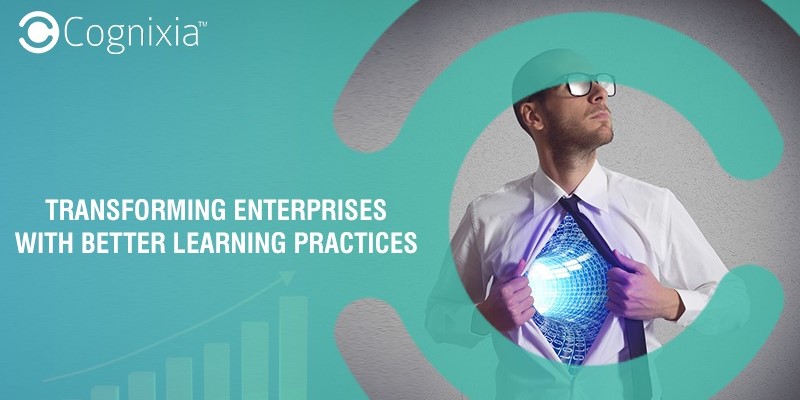Are you someone who believes that investing in corporate training is a supplementary expenditure? Does a Learning Management System (LMS) seem to be an overhead to you, bound to cause serious headaches in the long run? Are you skeptical about workforce training, and view it as a proposition more likely to result in a loss rather than profit? And lastly, do you feel most of your employees will be both uninterested and disinterested in getting themselves trained and upskilled?
If you harbor any of these perceptions and apprehensions, then fasten your seat belts and read this article thoroughly and carefully. It might change your perceptions about inculcating continuous learning practices in your workforce.

Dissecting the Enterprise Landscape
With the advent of Industry 4.0, emerging technologies and automation tools are becoming indispensable in the enterprise landscape. This has made the working environment more complicated and technologized – that is, requiring a higher degree of technical finesse. A large portion of the workforce is expected to possess basic data analysis skills and a fundamental knowledge of coding in any (or as many) of the programming languages.
Add to it the unpredictability brought about by the jobs requiring higher order of cognitive skills such as algorithmic and critical thinking, widespread data literacy, creativity, problem solving, and collaboration in real-time. These tasks categorized as non-routine work forms 40 per cent of the enterprise jobs today. And it is expected to embrace a larger chunk in the future, that is, 65 per cent of the jobs by 2028.
Takeaway: Two of the most important entities that will drive enterprise success in the future are: technical skills and cognitive skills amongst the employees. Ensuring the workforce laden with these two skills requires a continuous commitment towards learning and development through emerging technology training.
5 Infallible Learning Practices for Successful Corporate Training
A teacher can equally be held responsible for a pupil’s failure, which simply means – failure to make the subject engrossing.
-
Valuing Knowledge Capital at the Prime
The very first practice is to start looking at the investment on learning and acquiring knowledge capital as an asset rather than as an operating expense. This is simply because the future organizational success depends highly upon upskilled workforce. With this change in perspective towards knowledge capital, the next practice is to ensure a personalized, customized, and continuous skills development of the entire workforce.
-
Learning with the Flow of Working
The training content must seek the learner rather than the learner seeking the training content. This simply means embedding the learning platform into the native environment of an employee where they spend their time working. A separate learning management platform may become cumbersome for most of the employees. The idea is to enable learning with the flow of work which will help employees to cover greater grounds both in their work and in learning.
-
Inducing Agility into Learning
Rapid technology innovations have made the enterprise setting volatile. It seems a new technology is being introduced with every changing season, and a new update in the existing technology occurs with the changing calendar months. This unpredictability gives rise to agile learning. There is, after all, no use of learning a tool or technology that is on its way to become obsolete. Infusing agility into learning is, therefore, another significant practice that enterprises must facilitate amongst their workforce. The modern learner is afflicted by limited time and busy schedules and thus requires short, relevant, and engaging content for personalized, specialized, and self-directed learning.
-
Monitoring & managing your training endeavor
Only a well monitored system can remain the best system.Applying management practices in the training context enhances its operational effectiveness – learner satisfaction, quality of deliverables, eliminated inefficiencies, lowered costs, etc. These can be achieved through well managed performance scorecards with metrics and KPIs that can provide insights on training productivity and business impact. Emerging technologies such as Machine Learning & AI, Virtual & Augmented Reality, and Data Analytics can be utilized to formulate the relevant metrics and KPIs.
-
“Individual Ambition Serves the Common”
Learning at its best is a personal effort.Curiosity and a questioning mindset are the seeds of continuous learning. In an organization, every employee must have a short-term and long-term learning plan. The managers must make sure these plans are executed in the right direction. Once achieved, an individual must be rewarded, and inspired further not only to make learning a daily habit, but also achieving new milestones continuously.
A Word to the Professional Training Providers
It is a mere cliché to state that AI, Automation and other emerging technologies of Industry 4.0 will create more jobs than they will eliminate. A thought leader is capable of reading between these lines to infer that jobs are always going to be there, but the expertise and skills required for the jobs needs to be reinforced. If not, enterprises from the path of sustainable advantage will fall in the chasm of mediocrity and will ultimately be doomed to fade away.
Emerging technologies pose the threat of expertise in them becoming scarce. The foremost goal of a professional training provider is to address this scarcity and eliminate it with continuous learning solutions.

